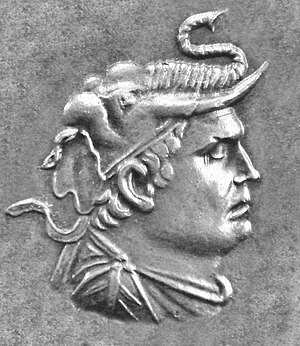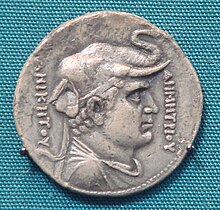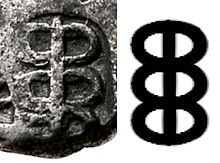Demetrius I of Bactria
| Demetrius I "the Invincible" (Aniketos) | |
|---|---|
| Greco-Bactrian/Indo-Greek king | |
 Portrait of Demetrius I. | |
| Reign | c. 200 – c. 180 BC |
| Predecessor | Euthydemus I |
| Dynasty | Euthydemid dynasty |
| Father | Euthydemus I |
| Religion | Buddhism, Hellenism |

Demetrius I (Greek: Δημήτριος Α΄) was a Greek king (reigned c. 200–180 BC) of Gandhara. He was the son of Euthydemus and succeeded him around 200 BC, after which he conquered extensive areas in what is now Afghanistan and Pakistan,[1] thus creating an Indo-Greek Kingdom far from Hellenistic Greece. He was never defeated in battle and was posthumously qualified as the Invincible (Aniketos) on the pedigree coins of his successor Agathocles.[2] Demetrius I may have been the initiator of the Yavana era, starting in 186-185 BC, which was used for several centuries thereafter.
"Demetrius" was the name of at least two and probably three Greek kings of Bactria. The much debated Demetrius II was a possible relative, whereas Demetrius III (c. 100 BC), is known only from numismatic evidence. Demetrius I was also known as the second Alexander.[citation needed]
Encounter with Antiochus III

The father of Demetrius, Euthydemus, was attacked by the Seleucid ruler Antiochus III around 210 BC. Although he commanded 10,000 horsemen, Euthydemus initially lost a battle on the Arius[3] and had to retreat. He then successfully resisted a three-year siege in the fortified city of Bactra, before Antiochus finally decided to recognize the new ruler.
The final negotiations were made between Antiochus III and Demetrius. Antiochus III was reportedly highly impressed by the demeanour of the young prince, and offered him one of his daughters in marriage, around 206 BC:
- "And after several journeys of Teleas to and fro between the two, Euthydemus at last sent his son Demetrius to confirm the terms of the treaty. Antiochus received the young prince; and judging from his appearance, conversation, and the dignity of his manners that he was worthy of royal power, he first promised to give him one of his own daughters, and secondly conceded the royal title to his father." Polybius 11.34[4]
The term used for "young prince" is neaniskos (νεανίσκος), suggesting an age around 16, which in turn gives a birth date for Demetrius around 222 BC.[citation needed]
Kuliab inscription
In an inscription found in the Kuliab area of Tadjikistan, in western Greco-Bactria, and dated to 200-195 BC,[5] a Greek by the name of Heliodotos, dedicating a fire altar to Hestia, mentions Euthydemus as the greatest of all kings, and his son as "Demetrios Kalinikos" "Demetrius the Glorious Conqueror":[6][5]
"Heliodotos dedicated this fragrant altar for Hestia, venerable goddess, illustrious amongst all, in the grove of Zeus, with beautiful trees; he made libations and sacrifices so that the greatest of all kings Euthydemos, as well as his son, the glorious, victorious and remarkable Demetrios, be preserved of all pains, with the help of Tyche with divine thoughts."[7][8]
— Kuliab inscription, 200-195 BC
Invasion of India

Demetrius started the invasion of northwestern India in 180 BC, following the destruction of the Mauryan dynasty by the general Pushyamitra Shunga, who then founded the new Indian Shunga dynasty (185–78 BC). The Mauryans had diplomatic alliances with the Greeks, and they may have been considered as allies by the Greco-Bactrians.[9] The Greco-Bactrians may also have invaded India in order to protect Greek populations in the subcontinent.[10]
Demetrius may have first started to recover the province of Arachosia, an area south of the Hindu Kush already inhabited by many Greeks but ruled by the Mauryas since the liberation of the territory by Chandragupta from Seleucus. In his "Parthian stations", Isidorus of Charax mentions a colony named Demetrias, supposedly founded by Demetrius himself:
- "Beyond is Arachosia. And the Parthians call this White India; there are the city of Biyt and the city of Pharsana and the city of Chorochoad and the city of Demetrias; then Alexandropolis, the metropolis of Arachosia; it is Greek, and by it flows the river Arachotus. As far as this place the land is under the rule of the Parthians." "Parthians stations", 1st century BC[11]
A Greek dedication inscribed on stone and discovered in Kuliab, a hundred kilometers northeast of Ai-Khanoum, also mentioned the victories of the prince Demetrius during the reign of his father:
- "Heliodotos dedicated this fragrant altar (...) so that the greatest of all kings Euthydemus, as well as his son, the glorious, victorious and remarkable Demetrius, be preserved of all pains, with the help of the Fortune with divine thoughts"[12]

The Greek campaigns may have gone as far as the capital Pataliputra in eastern India (today Patna):
- "The Greeks who caused Bactria to revolt grew so powerful on account of the fertility of the country that they became masters, not only of Ariana, but also of India, as Apollodorus of Artemita says: and more tribes were subdued by them than by Alexander — by Menander in particular (at least if he actually crossed the Hypanis towards the east and advanced as far as the Imaüs), for some were subdued by him personally and others by Demetrius, the son of Euthydemus the king of the Bactrians." (Strabo 11.11.1[13])
It is generally considered that Demetrius ruled in Taxila (where many of his coins were found in the archaeological site of Sirkap). The Indian records also describes Greek attacks on Saketa, Panchala, Mathura and Pataliputra (Gargi-Samhita, Yuga Purana chapter). However, the campaigns to Pataliputra are generally attested to the later king Menander I and Demetrius I probably only invaded areas in Pakistan. Other kings may have expanded the territory as well. By c. 175 BC, the Indo-Greeks ruled parts of northwestern India, while the Shungas remained in the Gangetic, Central, and Eastern India.
The Hathigumpha inscription of the Kalinga king Kharavela mentions that fearing him, a Yavana (Greek) king or general retreated to Mathura with his demoralized army. The name of the Yavana king is not clear, but it contains three letters, and the middle letter can be read as ma or mi.[14] Some historians, such as R. D. Banerji and K.P. Jayaswal reconstructed the name of the Yavana king as "Dimita", and identified him with Demetrius. However, several other historians, such as Ramaprasad Chanda, Sailendra Nath Sen and P.L. Gupta disagree with this interpretation.[14][15][16]
Indian coinage in Gandhara (after 185 BC)

The year 185 BC, with the invasion of the Greco-Bactrians into India, marks an evolution in the design of single-die cast coins in the coinage of Gandhara, as deities and realistic animals were introduced. At the same time coinage technology also evolved, as double-die coins (engraved on both sides, obverse and reverse) started to appear. The archaeological excavations of coins have shown that these coins, as well as the new double die coins, were contemporary with those of the Indo-Greeks.[17] According to Osmund Bopearachchi these coins, and particularly those depicting the goddess Lakshmi, were probably minted by Demetrius I following his invasion of Gandhara.[18]
Aftermaths

Demetrius I died of unknown reasons, and the date 180 BC is merely a suggestion aimed to allow suitable regnal periods for subsequent kings, of which there were several. Even if some of them were co-regents, civil wars and temporary divisions of the empire are most likely.
The kings Pantaleon, Antimachus, Agathocles and possibly Euthydemus II ruled after Demetrius I, and theories about their origin include all of them being relatives of Demetrius I, or only Antimachus. Eventually, the kingdom of Bactria fell to the able newcomer Eucratides.
Demetrius II was a later king, possibly a son or nephew of his namesake, and he ruled in India only. Justin mentions him being defeated by the Bactrian king Eucratides, an event which took place at the end of the latter's reign, possibly around 150 BC. Demetrius II left behind his generals Apollodotus and Menander I, who in turn became kings of India and rulers of the Indo-Greek Kingdom following his death.
According to Ptolemy, a Demetriapolis was founded in Arachosia.
Demetrius is a legend as well as an enigma. He was mentioned by Geoffrey Chaucer ("D, lord of Ind").
Demetrius and Buddhism

Buddhism flourished under the Indo-Greek kings, and it has been suggested by W. W. Tarn that their invasion of India was intended to show their support for the Mauryan empire in reaction to the persecution by the Sungas against Buddhism. However, that persecution in turn is debatable, with contemporary historians such as Romila Thapar suggesting that some of the accounts might be the product of exaggeration from Buddhist missionaries. Thapar attributes purely economic motivations to the Indo-Greek invasion of Southern Asia.[19]
Coinage and connection with Buddhism

The coins of Demetrius are of five types. One bilingual type with Greek and Kharoshthi legends exists; it is naturally associated with the Indian Demetrius II. A series with the king in diadem are likely to be early issues of Demetrius I.
There is also one series representing a Gorgon shield on the obverse and a trident on the reverse.
More interesting are the "elephant" coins: The first type shows Demetrius (I) with elephant-crown, a well-known symbol of India, which simply denotes his conquests in India, as Alexander the Great had also done on his coinage before.
Elephant with Nike

One type represents an elephant with Nike on the other side holding a wreath of victory. This sort of symbolism can be seen on the reverse of the coins of Antialcidas in which Nike (supported by Zeus) directly hands the victory wreath to the elephant on the same coin face.
Elephant with the caduceus


The other "elephant" type of Demetrius I represents a rejoicing elephant, depicted on the front on the coin and surrounded by the royal bead-and-reel decoration, and therefore treated on the same level as a King. The elephant, one of the symbols of Buddhism and the Gautama Buddha, possibly represents the victory of Buddhism brought about by Demetrius. Alternatively, though, the elephant has been described as a possible symbol of the Indian capital of Taxila (Tarn), or as a symbol of India as a whole.
The reverse of the coin depicts the caduceus, symbol of reconciliation between two fighting serpents, which is possibly a representation of peace between the Greeks and the Shungas, and likewise between Buddhism and Hinduism (the caduceus also appears as a symbol of the punch-marked coins of the Maurya Empire in India, in the 3rd-2nd century BC).
Unambiguous Buddhist symbols are found on later Greek coins of Menander I or Menander II, but the conquests of Demetrius I did influence the Buddhist religion in India.
Greco-Buddhist art
There are several parallels between Demetrius and the first representations of the Greek Buddha in human form.
Also in another parallel, the characteristic protector deity of Demetrius (Herakles standing with his club over his arm, as seen on the reverse of his coins), was represented in the Greco-Buddhist art of Gandhara as the protector deity of the Buddha.
See also
- Greco-Bactrian Kingdom
- Seleucid Empire
- Greco-Buddhism
- Indo-Scythians
- Indo-Parthian Kingdom
- Kushan Empire
Notes
- ^ Demetrius is said to have founded Taxila (archaeological excavations), and also Sagala in the Punjab, which he seemed to have called Euthydemia, after his father ("the city of Sagala, also called Euthydemia" (Ptolemy, Geographia, VII 1))
- ^ No undisputed coins of Demetrius I himself use this title, but it is employed on one of the pedigree coins issued by Agathocles, which bear on the reverse the classical profile of Demetrius crowned by the elephant scalp, with the legend DEMETRIOU ANIKETOU, and on the reverse Herakles crowning himself, with the legend "Of king Agathocles" (Boppearachchi, Pl 8). Coins of the supposed Demetrius III also use the title "Invincible", and therefore are attributed by some to the same Demetrius (Whitehead and al.)
- ^ Polybius 10.49, Battle of the Arius
- ^ Polybius 11.34 Siege of Bactra
- ^ a b Shane Wallace Greek Culture in Afghanistan and India: Old Evidence and New Discoveries p.206
- ^ Osmund Bopearachchi, Some Observations on the Chronology of the Early Kushans, p.48
- ^ Original Greek inscription:
τόνδε σοι βωμὸν θυώδη, πρέσβα κυδίστη θεῶν
Ἑστία, Διὸς κ(α)τ᾽ ἄλσος καλλίδενδρον ἔκτισεν
καὶ κλυταῖς ἤσκησε λοιβαῖς ἐμπύροις Ἡλιόδοτος
ὄφρα τὸμ πάντων μέγιστον Εὐθύδημον βασιλέων
τοῦ τε παῖδα καλλίνικον ἐκπρεπῆ Δημήτριον
πρευμενὴς σώιζηις ἐκηδεῖ(ς) σὺν τύχαι θεόφρον[ι]
in Shane Wallace Greek Culture in Afghanistan and India: Old Evidence and New Discoveries p.211 - ^ Supplementum Epigraphicum Graecum: 54.1569
- ^
- Description of the 302 BC marital alliance in Strabo 15.2.1(9): "The Indians occupy [in part] some of the countries situated along the Indus, which formerly belonged to the Persians: Alexander deprived the Ariani of them, and established there settlements of his own. But Seleucus I Nicator gave them to Sandrocottus in consequence of a marriage contract, and received in return five hundred elephants." The ambassador Megasthenes was also sent to the Mauryan court on this occasion.
- In the Edicts of Ashoka, king Ashoka claims to have sent Buddhist emissaries to the Hellenistic west around 250 BC.
- When Antiochus III the Great, after having made peace with Euthydemus, went to India in 209 BC, he is said to have renewed his friendship with the Indian king there and received presents from him: "He crossed the Caucasus (Hindu Kush) and descended into India; renewed his friendship with Sophagasenus the king of the Indians; received more elephants, until he had a hundred and fifty altogether; and having once more provisioned his troops, set out again personally with his army: leaving Androsthenes of Cyzicus the duty of taking home the treasure which this king had agreed to hand over to him."Polybius 11.39 Archived October 8, 2015, at the Wayback Machine
- ^ "Obviously, for the Greeks who survived in India and suffered from the oppression of the Shunga (for whom they were aliens and heretics), Demetrios must have appeared as a saviour" Mario Bussagli, p. 101
- ^ Mentioned in Bopearachchi, "Monnaies Greco-Bactriennes et Indo-Grecques", p52. Original text in paragraph 19 of Parthian stations
- ^ Heliodotos inscription, in "Afghanistan, ancien carrefour entre l'Est et Ouest", p133. ISBN 2-503-51681-5
- ^ Strabo 11.11.1 full text
- ^ a b Kusâna Coins and History, D.K. Printworld, 1994, p.184, note 5; reprint of a 1985 article
- ^ Sudhakar Chattopadhyaya (1974). Some Early Dynasties of South India. Motilal Banarsidass Publ. pp. 44–50. ISBN 978-81-208-2941-1.
- ^ Sailendra Nath Sen (1999). Ancient Indian History and Civilization. New Age International. pp. 176–177. ISBN 978-81-224-1198-0.
- ^ Ancient Indian Coinage, Rekha Jain, D.K.Printworld Ltd, p.114
- ^ Osmund Bopearachchi, 2016, Emergence of Viṣṇu and Śiva Images in India: Numismatic and Sculptural Evidence
- ^ Thapar, Romila (1960). Aśoka and the Decline of the Mauryas. Oxford University Press. p. 200.
References
- McEvilley, Thomas (2002). The Shape of Ancient Thought. Comparative Studies in Greek and Indian Philosophies. Allworth Press and the School of Visual Arts. ISBN 1-58115-203-5.
- Puri, B. N. (2000). Buddhism in Central Asia. Motilal Banarsidass Pub. ISBN 81-208-0372-8.
- Tarn, W. W. (1951). The Greeks in Bactria and India. Cambridge University Press.
External links
| Preceded by: Euthydemus I |
Greco-Bactrian and Indo-Greek king 205–171 BC |
Succeeded by: (possible sub-kings) (in Bactria) Euthydemus II (in Paropamisadae) Agathocles (in Arachosia, Gandhara) Pantaleon |
